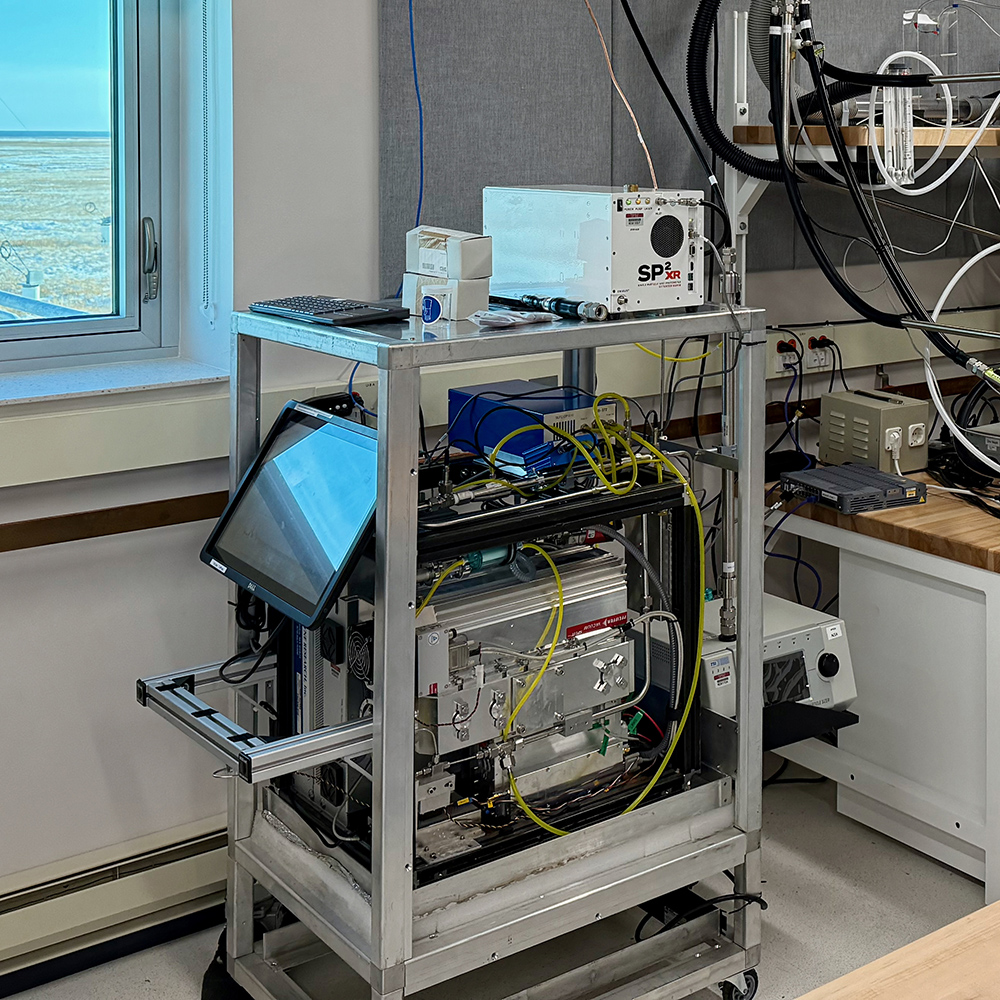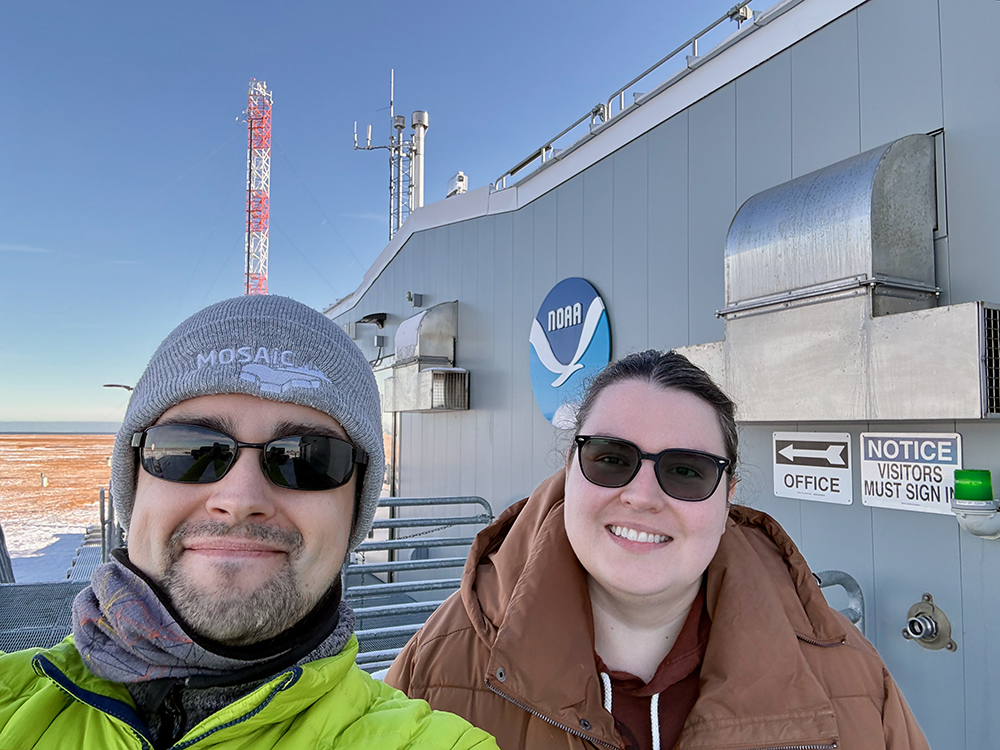Users Ask for New Arctic Aerosol Measurements, and ARM Listens
Published: 26 November 2024
ARM installs set of aerosol instruments at neighboring NOAA facility in Utqiaġvik, Alaska

The Atmospheric Radiation Measurement (ARM) user facility, in collaboration with NOAA, is filling a need for additional aerosol measurements at the “top of the world” to help give scientists a richer picture of atmospheric particles in the Arctic.
For more than 50 years, NOAA’s Federated Aerosol Network has collected particle number concentration, scattering, and absorption data at Utqiaġvik (formerly Barrow), Alaska. The current NOAA site at Utqiaġvik is about 100 meters (0.06 miles) from the central facility of ARM’s North Slope of Alaska (NSA) atmospheric observatory.
ARM and NOAA have been partners in Alaska since ARM began operating the NSA in 1997. Given the existing NOAA aerosol measurements, ARM did not deploy its own Aerosol Observing System at the NSA. NOAA has historically provided aerosol measurements from its Utqiaġvik location to ARM, which has processed them to produce data products consistent with those at other ARM locations.
From October 1997 through August 2021, NOAA hosted aerosol instruments in its original Barrow Atmospheric Baseline Observatory building, which is classified as NSA external site X1 in the ARM Data Center. In 2020, NOAA finished constructing a new building next door—classified as NSA X3—to replace the X1 facility. Aerosol instrument operations in both buildings overlapped for almost a year before data collection ended at the X1 facility. X1 and X3 measurements are all available from the ARM Data Center.

Other collaborators at Utqiaġvik have collected long-term data on black carbon mass concentrations, organic and inorganic components, and particle size distribution (fine fraction, 10 to 500 nanometers).
Even with all these measurements, observational gaps have remained. To help close these gaps, ARM has installed the following aerosol instruments at the NOAA site:
- aerosol chemical speciation monitor (ACSM) – an instrument that measures non-refractory—or rapidly evaporating—submicron aerosol chemical composition (organics, sulfate, nitrate, ammonium, and chloride) every 10 minutes
- aerodynamic particle sizer (APS) – a spectrometer that measures full particle size distribution (coarse mode, 0.5 to 20 microns)
- single-particle soot photometer – extended range (SP2-XR) – an instrument that uses a laser to measure refractory black carbon in individual particles and provides the geophysical units so less data processing is involved.
Together, these ARM instruments constitute a new NSA extended facility, E30.
ARM aerosol instrument mentors Janek Uin and Maria Zawadowicz, both from Brookhaven National Laboratory in New York, went to Alaska to install the instruments at the NOAA site in early October 2024. As part of the ARM-NOAA collaboration, NOAA technicians check on the ARM instruments as part of their daily rounds.
ARM’s lead aerosol mentor, Brookhaven atmospheric scientist Olga Mayol-Bracero, recalls several science meetings at which ARM users and scientists funded by the U.S. Department of Energy’s Atmospheric System Research (ASR) program area expressed the need for more aerosol measurements at Utqiaġvik.
The timing was right to move forward with these requests after the 2022 Joint ARM User Facility/ASR Principal Investigators Meeting in Rockville, Maryland. That was when Mayol-Bracero and others from ARM began talking with NOAA about how they could work together to add the new measurements that scientists wanted.
“ARM has been aiming to have aerosol measurements at NSA at least since 2017, so it is exciting to finally see this happening.”
Olga Mayol-Bracero, ARM’s lead aerosol mentor
“ARM has been aiming to have aerosol measurements at NSA at least since 2017, so it is exciting to finally see this happening,” says Mayol-Bracero.
Access the New Aerosol Data
APS and ACSM data from NSA E30 are now available in the ARM Data Center. The APS data can be cited as doi:10.5439/1407135 and the ACSM data as doi:10.5439/1865399. (For the ACSM, please note that these are baseline data, and mentor-processed data will be released at a later date.)
Work is underway to make the SP2-XR data available in the ARM Data Center. Once available, the SP2-XR data will also be accessible via the NSA E30 location page or through this ARM Data Discovery link to all NSA E30 data.
Get Additional Information
More details about the new NSA aerosol measurements can be found in the ARM Fiscal Year 2025 (FY2025) Aerosol Operations Plan.
If you have questions or comments about any of the instruments or their data, please reach out to the appropriate lead mentor—Zawadowicz (ACSM), Ashish Singh (APS), or Art Sedlacek (SP2-XR)—through ARM’s instrument mentor contact page.
For a comparison of the NSA X1 and X3 aerosol instruments, please read this 2021 ARM technical report.
Future NSA Aerosol Data
A Portable Ice Nucleation Experiment (PINE) chamber from West Texas A&M University operated at the NOAA site for nearly three years as part of an ARM field campaign to study ice-nucleating particles. The principal investigator, Naruki Hiranuma, says his team is aiming to release the PINE data to the ARM Data Center next spring.
Also, ARM plans to establish ice-nucleating particle measurements at the NSA in FY2025 as time and effort allow. Learn more in the ARM FY2025 Aerosol Operations Plan.
Keep up with the Atmospheric Observer
Updates on ARM news, events, and opportunities delivered to your inbox
ARM User Profile
ARM welcomes users from all institutions and nations. A free ARM user account is needed to access ARM data.


















